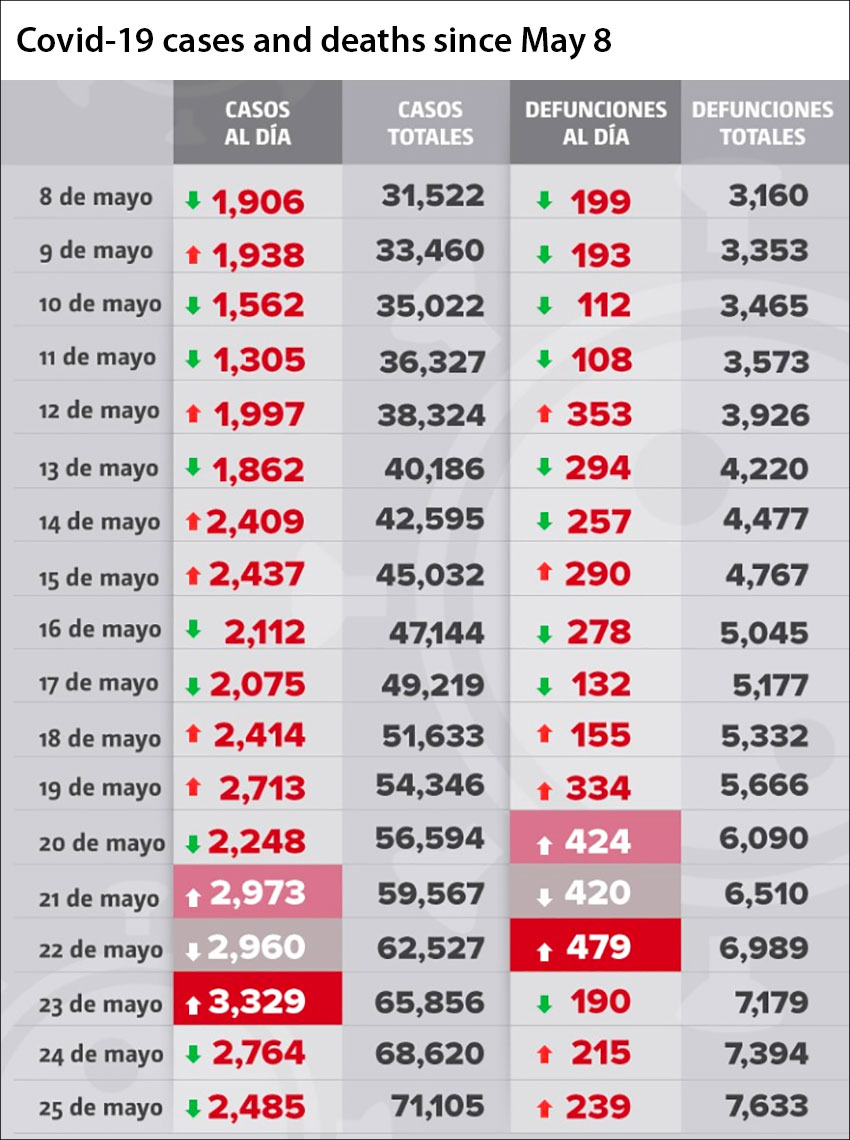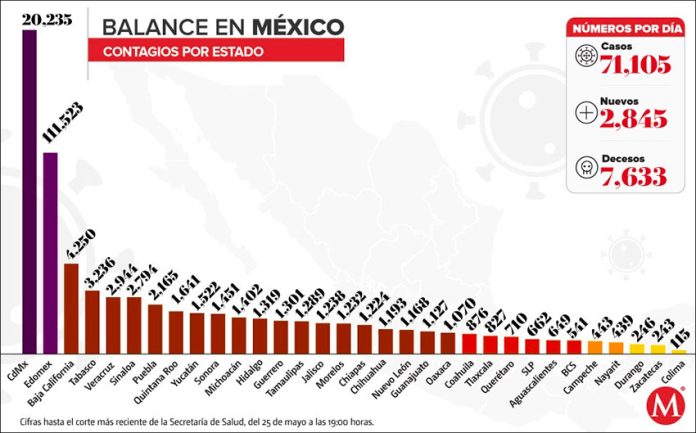The coronavirus pandemic continues to grow across Mexico but one state had cause for celebration on Monday: not a single new case was reported in San Luis Potosí.
Health Ministry Director of Epidemiology José Luis Alomía told a press conference Monday night that 71,105 people have now tested positive for Covid-19 since the start of the pandemic, an increase of 2,485 compared to Sunday.
He also said that there are 29,509 suspected cases across the country and that 225,650 people have now been tested. Just over 14,000 of the confirmed cases are considered active, according to Health Ministry data.
The official coronavirus death toll increased to 7,633 on Monday with 239 additional fatalities reported. Mexico has now recorded more Covid-19 deaths than all but eight countries, according to global data compiled by the Johns Hopkins University.
In addition to the confirmed Covid-19 deaths, 641 fatalities are suspected to have been caused by the disease but have not yet been confirmed.

Mexico City continues to be the epicenter of the national coronavirus outbreak, leading the country for accumulated cases, active cases and deaths.
More than 20,000 Covid-19 cases have now been detected in the capital and on Monday it passed the grim milestone of 2,000 coronavirus-related deaths. However, several media reports have claimed that authorities are drastically undercounting Covid-19 fatalities in Mexico City and that the real death toll is therefore much higher.
The capital currently has 3,654 active cases, two and a half times the number in neighboring México state, which has the second largest active outbreak in the country with 1,422 cases.
Tabasco has the third largest active outbreak followed by Veracruz, Sinaloa, Baja California and Puebla. All five states have more than 500 active cases.
After every state in the country reported at least one new case every day last week, San Luís Potosí bucked the trend Monday with no new infections detected. The Bajío region state has recorded 662 cases since the start of the pandemic of which 214 are active. It has the sixth lowest coronavirus death toll in the country with 40 fatalities.
After Mexico City, which has now recorded 2,024 fatalities, México state has the second highest coronavirus death toll among the nation’s 32 states with 872 people having lost their lives to Covid-19 as of Monday.

Nine other states have recorded more than 200 deaths: Baja California (705); Tabasco (416); Sinaloa (406); Veracruz (372); Quintana Roo (294); Puebla (260); Chihuahua (255); Morelos (239); and Hidalgo (215).
Across Mexico, 68% of the more than 7,000 Covid-19 fatalities have been men while women account for the other 32%. The three most common underlying health conditions among those who have died are hypertension, diabetes and obesity.
Based on confirmed cases and deaths, Mexico’s coronavirus fatality rate is currently 10.7 per 100 cases, well above the global rate of 6.3.
Almost three months have now passed since the first case of Covid-19 was detected in Mexico and the national social distancing initiative has been in effect for more than two months.
However, the initiative will conclude on Saturday – exactly two months after the federal government declared a health emergency – and a color-coded stoplight system will thereafter be used to determine each state’s readiness to return to what is being called the “new normal.”
Deputy Health Minister Hugo López-Gatell said Monday night that the end of the national social distancing initiative – during which nonessential economic activities have been suspended and authorities have urged citizens to stay in their homes – is no cause for celebration.
“What will be celebrated on May 30? From my point of view nothing in particular. What we’ll have to do on May 30 is be aware that, with respect to Covid, we still have an active epidemic,” he said.
López-Gatell stressed that some states could be allocated a red light, meaning that there will be few if any changes to the coronavirus mitigation restrictions currently in place, while others will be assigned orange or yellow lights.
“That means that there will be restrictions. If you don’t work in an essential activity, you won’t be able to go to work if the stoplight in your state is red. If you live in a state where the stoplight is orange, you won’t be able to return to public spaces for recreational activities. … There’s nothing to celebrate; [we should] simply be aware that we’ve managed to reduce the intensity of infections by 75%, that we’ve still got a long way to go [in the pandemic] and that success depends on everyone in society.”
Source: Milenio (sp)
